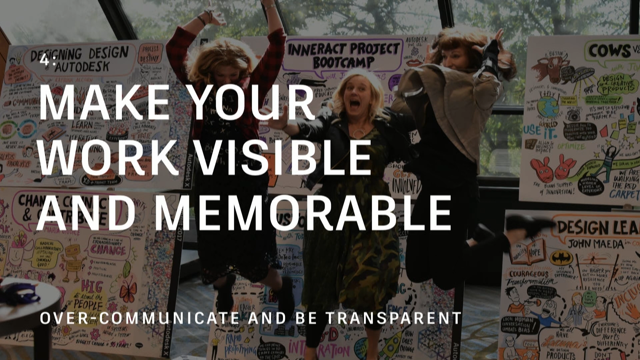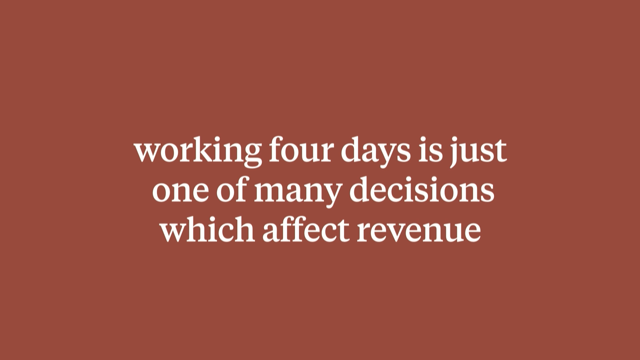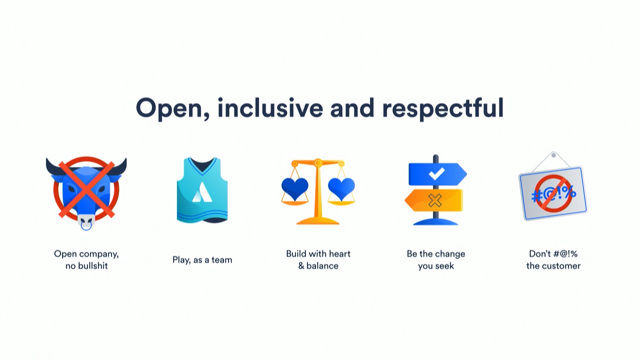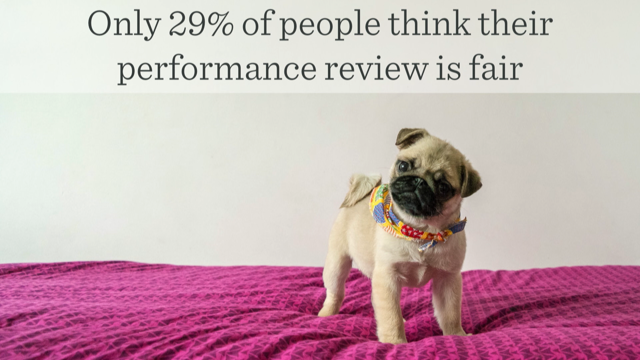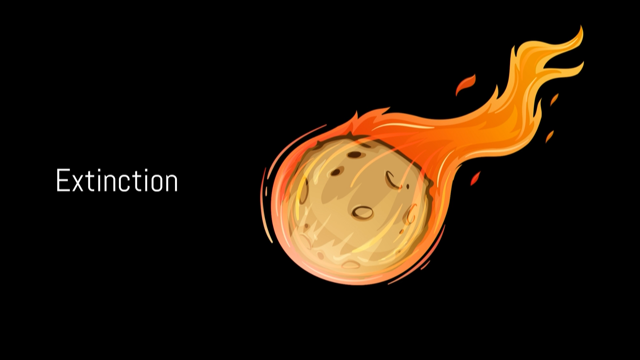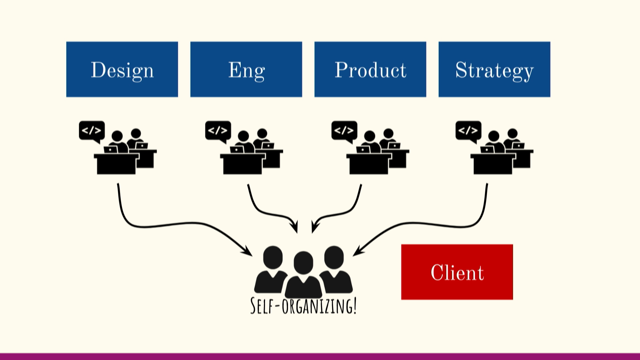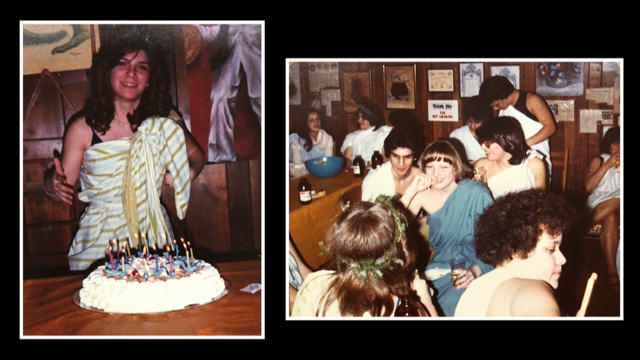
(upbeat playful music) - All right, well first thing's first.
Yes, it definitely sucks going last.
But I have been incredibly inspired by all the great speakers throughout this whole day on the topic culture.
A topic that I'm incredibly passionate about. I don't even know if any of the speakers are still here, but let's give them a big round of applause. Yeah.
(applauding) And then, actually I wanna give you guys a round of applause for sitting in this room all day, and you're still here and you're showing up. So round of applause, thank you.
I'm eternally grateful that I'm not talking to 10 people. So one of the benefits of going last, though, is sitting through all of the talks.
I get to kind of tie everything together, kind of make sense of the day.
And so with my talk, you know, as all of the talks have resonated to me in my, almost 30, over 30 year career as a design leader. And I think I've done all of those things.
Good, bad, and ugly.
So I'm gonna tie all these things together and really reflect on my world experience.
So first, this is me.
It's not moving.
Help.
There we are, that's me.
That's me, I'm 16 years old there.
That was my sweet 16 toga party.
And those are my friends and that's actually, you know, the basement of my house in New York.
Wood panel walls.
I think my paintings were kind of stapled to the wall. And I was really known, when I was growing up, I had the party house.
I was really great at throwing parties.
And getting people together to do things like throw on a toga.
So good that I even got my mother and father involved in the process.
So I feel like the parties at that point when I was 16 years old, they were kind of my super power. And I went to art school.
I went to a school in New York called Cooper Union. Went in as a fine artist, came out as graphic designer. And I accidentally moved to San Francisco when I was bout 23, 24 years old.
That guy in white was my boss, Richard Saul Worman. And he got the gig, now this is pre, this is at the dawn of the digital age.
He got the gig to redesign the Pacific Bell Yellow Pages. How many people here remember the yellow pages? You remember that? I'm dating all the old people here.
But the thing I loved about the yellow pages, that project, it was like pre-internet.
It was the only thing that tied people in communities together.
So I moved to California to work on that project. And really, it became sort of a startup to reimagine what the yellow pages could be. And that's me over there.
And in, you know, right out of school, in very short order, I was assigned map duty. So I was in charge of designing all of the maps for the yellow pages, which is over 100 different books for all of California and Nevada.
And I had to like, basically, hire people, never done it before, to help me design these maps.
And so within about one to two years of landing in California, I was a creative director of like 20, 25, 30 people who were all in charge of designing maps.
And they all had to look the same.
They had to feel the same.
So you had to kind of create a unified design system and a process around designing these maps.
It was also the beginning of the computer age, so we had to invent new processes as well.
So it turned out like that party super power translated into collaboration power.
I was really good at getting groups of people together to believe in a mission, to collaborate together, to execute to a high degree of quality.
So then fast forward.
In 1997, I had left, I had worked for the yellow pages for a couple of, and designing maps.
I had left, travelled, and came back.
Didn't have anything to, didn't have a job. Didn't have a place to live, so what do you do? You start freelancing.
So I started freelancing.
Got busy.
Next thing you know, accidentally founded a design studio. Usually those are the ways those things happen. So I founded this company in 1997 called Hot Studio. And I grew that company from one person, me, to 100 people over a 15 year period.
Based in San Francisco and New York City.
And so a large part of my life experience comes from understanding, you know, what it means to have a one person company, a 10 person company, a 25 person company, a 50 person company, a 100 person company.
Thousands of people working.
So at Hot Studio, Michael kind of talked about this, is I had the beauty to design the company that I wanted to have.
And that's one of the, there's a lot of hard work that goes in running your own company, but there's also this ability to really define your values and the culture and the way you wanna live your life. And so for me, when I was running Hot Studio, in the back of my head as the CEO, I wanted it to be thought of as the best job you ever had in your entire life. That was sort of my goal.
My goal was that you were gonna come work at Hot Studio and that years later, you're gonna say, God, that was the best job I ever had. I had met lifelong friends.
I have done my best work ever and I had the best boss ever.
And so that was the culture that I wanted to kind of create.
I wanted that sort of take away, that memory. And so Hot Studio over the years, was really known for its incredibly strong culture and the people that worked there.
And consequentially, when you have a healthy culture and you have, and it attracts great people, you can aspire to the highest degree quality possible. So all of that belongs together.
So then over a 15 year period, grew the company about 100 people.
In 2013, Facebook was one of my clients at the time. Now Facebook was pretty small at that time. As a matter of fact, they had, I think Facebook started in 2008 so it was only, it was not that many years old.
Mark looked like he was like, you know, a teenage child, man baby.
And there were only about like 50 designers at Facebook at that time.
So Facebook acquired, wanted to acquire my company, which, I let them.
And so Facebook acquired the talent behind Hot Studio and it became one of the largest acquisitions ever done to date for a design studio.
And the thing that's so impressive about that is that this acquisition wasn't based on EBITDA or profit margins or the client list that we had. This acquisition was completely based on quality of its people.
So you might say building culture is my super power as well. In 20, so I went from Hot Studio to Facebook 2013, and then in 2015, I left Facebook to join Autodesk.
Does anybody know Autodesk? They create 3-D software, a lot of you do.
So I went to join Autodesk as the vice president of design at Autodesk.
It was the highest position that a designer ever had in that company's 33 year history. And my job then was to build a strong design culture in a traditionally engineering centred organisation. So when you kind of look at my lifespan, I have the life experience of starting my own company. At Facebook, I was a director of product design where my job primarily was to work with teams and ship product.
And then moving to Autodesk, my job was to actually be a culture changer, to change the company culture from being centred on engineering, to being much more design focused.
So all of that really points to people in culture. And what's been really nice today, this breath of conversation about culture is you know, we're not really talking about this noun, this thing, this inhuman kind of lifeless thing about culture.
It's like this set of values, these practises. These are all parts of the equation, but culture is not really about like a playbook, and a lot of people were talking particularly about, like you could have values, but if you don't imbue those values, it's just a stupid exercise. Culture is really what I love to, what I think is much more relevant is what the CEO of Southwest Airline says.
Culture is what people do when no one is looking. I think that that is really important because when I think about culture and I think about it's the thing that gives organisations life.
It's like the blood of organisations.
It flows through your veins.
It's the social contract that you have with one another. And it's the social contract around shared values, your promises, your commitment, and how we choose to treat one another.
Culture is really a human activity.
And there was talk about this challenge when you're working, especially in engineering organisations, product organisations, and maybe even government organisations, where time is money.
A lot of people don't wanna invest in cultural activities. It doesn't, you know, it's almost a contradiction. It's against billable hours.
Or it takes you away from your product work. There's a million reasons why people don't wanna invest in culture.
But the data is the data and the fact is that good culture is good for the bottom line. When you have a very strong culture, people wanna come to work.
So they're not absent.
When you have a really strong culture, there's less management overhead because people take their own responsibility in making the culture healthy. It increases employee loyalty and retention. When people love to come to work, they'll tell others so it's a great recruiting tool, but people wanna stay where they're valued. And we talked a lot about the importance of things being good for your health and well-being. At the end of the day, life is short so you have to do things that make you happy. It's also important, it strengthens your brand. So especially the millennial generation, where people really shop their values, it's important that the culture reflects what happens inside the organisation, is equally important as how you're treating your customers outside the organisation.
I would argue that there's actually no borders between what's inside and what's outside of an organisation.
And finally, it's just really the right thing to do. The end of the day it's about improving your quality of life.
So I've been at this for a long time.
I've had a career over 30 years now and you know, as I mentioned, I have a lot of small company experience? How many people work in companies that are under 20? Okay, so about five.
How many people work in companies around 100 or under 100? And then how many people work in companies that's like 3,000 or more? Okay, so it's a really good spread.
And so I just put together some things that I consider life, these are things that I actually did.
Whether it was in a short, small company or a large company.
These are the things that I did.
And a lot of these have already been said so I'm gonna reference them.
So the very first one, oh and...
This was mentioned a couple times today.
Some of these things might seem obvious, but then why aren't they being done? So that's something to kind of reflect back. It's like, oh yeah, yeah of course we need to treat people fairly.
Well then ask yourself in that reflection process, well why aren't people being treated fairly. So it's important to say, but it's more important to do.
And if a company is saying and not doing, that's a big flag for you.
So the very first one is treating people equally. You know, the success of all business at the end of the day lie in people and how we can make powerful, meaningful connections to one another. It doesn't really matter how many awards we've won, what the job title says, or how many years we've been working in business.
It's really important to go to work regardless of your job title and consider yourself a peer. When people feel like they're treated equally in organisations, that is when great things can happen. And it really starts with you.
Whether you're an intern.
Whether you're a high level manager or a leader. Whether you're a middle manager.
If you come to work treating people equally, that's when wonderful things can happen.
Now Carmello mentioned it a lot, about this idea of being valued, being heard and respected. To me, that is a culture that is where people feel like they're treated like equals.
Dom also talked about the importance of equality in an organisation.
So this is something you can all do.
Which is to try to figure out what those false walls are and try to break down those barriers that prevent people from connecting to one another.
And important to focus on being present and looking people right in their eyes, that exercise that Dom did this morning was really powerful and uncomfortable, right? And then really being aware of listening.
All of those things were discussed just a little while ago. And at the end of the day, it's important to assume competency in your coworkers, so make sure that have faith in their abilities. So the whole idea of trust is incredibly important. And to meet people where they are in their life. How many people here feel like they work in a diverse organisation? That's good amount of people.
So of those people, how many people have 50% women working in their company? That's really great.
What about age diversity? Young, good combination of young and old.
And race, religion, age, point of view.
It's really great, going around Sydney, I was really struck by the international population of people here.
And the whole, with diversity, it's a bit hot topic now and there's tonnes of studies out there that talk about diversity improving the bottom line. So there's data that shows companies that are diverse actually perform better and the work leads to more innovation.
Because you have this ability to have these life experiences, companies are being increasingly more global.
It provides a level of empathy that gets fed back into the product experience.
And you know, I'm frankly so tired of my whole career as a woman leader.
We got 12% women, isn't that great? We got 30% women, isn't that great? Enough is enough.
It's time to have 50% women, 50% men and get on with it. So there's this thing in San Francisco, there's a thing in the US called the Rooney Rule. Has anybody ever heard of this? Some of you have.
You guys are gonna get gold stars.
But there's a Rooney Rule where it came from the NFL, the National Football League, where there was a requirement that coaches, when you went recruiting for people, that you must be recruiting from a diverse slate of candidates.
That you cannot just recruit from people that look like you or a non-diverse candidate.
And when I think about what prevents diversity, is it's an investment in time.
That's really what it is.
It just takes longer to build diversity in your organisation.
When you think of the long term benefits of diversity, it makes sense.
But that might mean that you're gonna, maybe you do need quotas.
Maybe you do need to skew and bias towards diversity. And get out of this idea of, let the best candidate win. Well if the best candidate is not part of a diverse pool, they may not necessarily be contributing, be as powerful as a contributor as somebody who has a completely different point of view, that's gonna bring in new, fresh ideas.
So it's important to invest, whether, you know lesson for seek because of the time and energy. And then once you bring diversity in, once you commit to diversity, every person here who can hire somebody, you are all on the hook to creating diversity.
You need to look at your team and ask yourself, do I have a diverse team that I'm working with. And once you bring diversity into organisations, it's important to set people up for success because people who are coming in, maybe it's women, maybe it's a minority, maybe it's somebody who's older, you can be what you can't see.
So it's important to set up systems in place so that these people can thrive and feel comfortable to express themselves and be open to new ideas and diverse opinions. And to pay attention to discrimination and unconscious bias in the workplace because that's a real thing.
Number two.
Environment, making your work fun.
How many people, who here in this room can guess how many hours, you might know.
You're gonna be quiet then.
How many hours does the average person work in their lifetime? Can you guess? - [Man] Too many.
- Too many is right, that's a good answer.
How many hours? Do you know, Michael? You don't know.
How many? - [Man] 100,000.
- 100,000, anybody else? 100,000's pretty close.
So the average person works 90,000 hours of work over their lifetime, 90,000 hours.
And that's a third of your life devoted to work. And I don't know about you, but especially with it almost feels everyday that the world's gonna end.
I don't know, Armageddon is here.
So I really do feel like life is short.
Everyday should count right now.
So I really do believe that if you're gonna be going to work, make work fun because it's not worth being miserable at work. It's not worth your time.
So that was one of the things that I tried to do anywhere I went.
This is a picture of a onsie day at Facebook. So now Facebook is an incredibly intense environment to work in.
I know that it has all the perks and you see all the stuff, but it is, there's lots of tears and it's a really stressful environment to work in. But anybody could make work fun.
So this was championed by one designer in one group. And she put something out and next thing you know, there are literally hundreds of people coming into work at Facebook in onsies.
So this is something that anybody can do at any time, is to find those opportunities where you can imbue that sense of fun and culture.
And it doesn't have to be, it doesn't have to cost any money to do it.
Positivity, yes.
This one really comes down to literally, do not be an asshole.
You know, growing up as a designer, you know, they talked about, somebody talked about, I think it was Dom, the rockstar in the corner. And that there was this idea that somehow going to work, you had to work for an asshole in order to be innovative.
And you know, one of the things that having a kid, I have two kids.
And when you have kids, actually you become better managers because you realise so many things that you do as a parent really apply to your employees.
And one of the things that you know when you're a parent is that you need to model the behaviour.
So it you're gonna, you know, if you wanna go to work and you wanna be an asshole, would you do that to your kids? Would you go home and yell at your kids and make them cry? So as a leader, it's important to model that behaviour and come to work with a positive attitude every day. It doesn't mean that you're not gonna be honest and open and have difficult conversations. But there's no room for meanness at work.
It's just a job.
And everybody wants to do a good job.
It's just the people who get in the way.
There's a data point that talks about bad bosses, that they could increase the risk of stroke by 33%. I could totally believe that because I have had some asshole bosses in my time.
On a positive note, thought, nine out of 10 people say that they're more productive when they're around positive people.
And increasing positive emotions could lengthen the span by 10 years.
How many people could bring their dog to work? A lot of you, how is it? What is it like? What was that? Yeah, who else brings dogs to work? Can anybody talk about the benefits of what it's like to have a dog? What's it like to have a dog at work for you? (woman speaking without mic) Oh, so that's easy.
Yeah, yeah.
What about others? What's it like to bring a dog to work? (woman speaking without mic) Yes, oh yeah, there's the breaks, of course. (woman speaking without mic) Yes.
Yes.
Absolutely.
So the thing about pets, studies prove that pets at the workplace make people happier.
They lower stress levels.
And they create comfortable, flexible environments. And the other thing that dogs do is it creates these moments where somebody will come and pet your dog. This might be someone you're not working with at all, so it creates these other interpersonal connections that kind of take you out of the structure of your job and kind of open you up to new ideas. So it's incredibly therapeutic.
And more and more studies, pets are in hospitals and hospices now.
I feel like if you could bring a dog to a hospital, you could definitely bring one to work.
So upping my game, what about bringing a baby to work? How many people have brought babies to work? That is so awesome.
So tell me, what was that like? (man speaking without mic) Fantastic.
What about you guys over there? Were they your babies, obviously or you stole somebody's babies.
What was it like? (woman speaking without mic) Yeah.
So when I was starting my company I had two kids, and I had to work.
So I would bring my baby to work.
You just kind of like, you basically have to design a solution to bring the baby to work.
So I brought the baby to work to work.
And then I realised, then the people who worked for me started having babies. And so we created this babies at work programme. Now when you're a new parent, whether you're a father or a mother, it is so traumatising to have a child and then return to work.
That experience, you feeling like you've given birth to this baby and then suddenly you have to go back in. It's traumatic.
So this programme that we had at Hot Studio was that you know, parents would bring their baby. And they can bring them because they're slugs when they're little, they're sleeping anyway. And you're brain dead anyway.
You might as well be brain dead at work.
And then you have helpers.
So two helpers would sign up to help you, so you didn't feel like you were a burden to them. And this programme was incredibly powerful at Hot Studio. First of all, increased diversity.
It attracted more women to come work for Hot Studio. But it also created this incredible retention and company loyalty.
When the company is working on your behalf, you wanna stay in that company.
You wanna work harder.
Your morale increases.
And you actually become more efficient with your time. So this is one of those taboo areas.
It's great to see that people are doing that. More and more companies should be able to do this. Okay, number three.
Be present, accessible, and available.
How many people know the company, Zappos? Zappos.
Tony Shay is CEO of Zappos, and he has a great book called The Culture Book. And he is known for creating an incredibly powerful, healthy corporate culture.
Also for impeccable customer service.
And this is a picture of his desk.
His cubicle, sitting right in the centre of the action. You know, there's a lot of controversy around open space environments now.
Not gonna get into that.
That's less important to me than you as a leader putting yourself in the centre of the action. Not in the corner room.
It speaks miles when you are a leader and you are in with your people.
As a matter of fact, when I was at Facebook, Mark, although very intimidating, sat in the middle of the office.
You could walk by him.
And at Hot Studio I made sure I had the shittiest office, the shittiest desk.
And everybody had to walk past me in the morning to say hello.
So it breaks down, helps break down that barrier in creating that, break down that wall of hierarchy when you are incredibly present and accessible and available to people.
So I think it's really important to remember to be available whenever somebody has a question. Okay, so soliciting feedback continuously.
So we heard that a lot.
Joe talked a lot about feedback.
Cheryl Sandburg used to say feedback is a gift, and then she'd make you cry.
But my saying about feedback is feedback should never be a surprise.
If you are surprised to get feedback, your manager hasn't really done a really good job setting you up and giving you that feedback on a regular basis.
It's really important to be humble and to constantly solicit feedback.
I would constantly ask people, how can I do better? Whether it's an employee or a manager or somebody that I reported to.
So at Hot Studio, I would do this thing called the listening tour.
It was you know, definitely an activity that enabled introverts as well as extroverts to have a point of view.
And I would do this tour and have people really comment on culture or process or staffing or quality. And we would then dot vote the biggest issues and create an action plan.
Joe talked about the importance of doing something with the feedback.
Collecting all the data and prioritising and then that became our action item for the year. And that feedback, that listening tour, note that it was listening tour on my part, really helped improve the culture over time. And it also gave people the trust to feel like they can speak up and have a voice, especially if you can act on the action.
So feedback always leads to course correction, new discoveries, and new directions.
And it's important to have that mechanism in your business continuously.
So number four, learn and grow.
There are six by the way.
It's super important to promote curiosity and lifelong learning at work.
I mean, that's how you do better products.
That's how you create a stronger culture.
Research has shown that creating and making things by hand, actually enhances mental health and helps us, makes us much more happier.
So our world is increasingly more and more digital. There's great opportunities where you can actually get really tactile.
And when you are actually making things by hand, it enables people to get into a flow state, which actually enhances creativity.
So think of that as an option when the next time you're with your group.
Go out and make something.
It helps relieve anxiety, modify depression, and create a great bonding experience over shared sense of accomplishment.
And so to go from making to actually digital, how many people have done hackathons? Successful? More or less.
Did anybody wanna mention how has, is that good for the culture for you? How often do you do hackathons? (man speaking without mic) Uh-huh.
Well, you know, I really got into hackathons when I was at Facebook.
So Facebook would have hackathons every month. They would take two to three days a month to just do hackathons around a certain theme. And I saw how powerful it was to actually kind of unblock people, because it's so easy when you're shipping product to get locked into this narrow view, following KPIs, okay, whatever the fuck you wanna call it.
But you know, the hackathon allows you to kind of like open up.
And so I took this idea and brought it to Autodesk. And at Autodesk, so I was cosponsored with the engineering leader and we got 600, over 630 participants worldwide to participate. From over 630, 176 teams were formed over 23 offices. And they made about 192 projects.
And the really important thing about this, other than kind of opening up ideas to new innovations, was that 76% of the people never got to work together before.
So this idea of hackathons and bringing that in to your environment to kind of open up new ideas is really worth while.
People can say, I remember the naysayers at Autodesk. Well how much time did that take away from actually shipping real product? Well a lot of the things that come into hackathon, come from hackathon, especially from Facebook, actually become new product ideas.
So it's short term thinking versus long term gain. And when I was Autodesk, my boss, so at Autodesk I was responsible for 400 people around the world.
So there were 400 designers all over the world. And many of them had never actually met face to face. And we were, I forgot who it was he was talking about, the benefit, what's your name again? Georgina talked about remote versus in person. And it's really not either or, it's an and. You need to have ways to connect people more in remote situations, but it doesn't replace the value of seeing people face to face.
And many people at Autodesk had never met each other before. So my boss asked me to put together a summit to connect the design community together.
And here's a short clip of what I did.
(upbeat music) Making things by hand.
- I just wanna say one thing.
I mean, huge props to you guys for putting this thing together.
It's been an amazing - That was my boss. - Couple of days, I know you know that.
But the fact that you kind of did it by yourselves organically, sort of crowd sourced this whole event, this is fantastic.
- I think you've gathered all the extroverts who work at Autodesk.
- [Maria] That's the CEO.
- I've never been in a room with like 300 people who work at Autodesk that's this loud or this much fun.
(cheering) - So bringing people together, people who work together, they use all the digital tools, but the fact that they were in the same room, the fact that they were sharing information. Sid talked about the importance of communities practise, opening your practises.
This became an incredible moment of sharing and also connection.
And a lot of people didn't realise that they were working on teams, but potentially working on solving the same problem.
Does that happen a lot in large organisations? So then they made the necessary connections, and this became part of the company cultural shift from being engineering centred to being much more people centred.
So it stuck, and we did three of those at my time at Autodesk.
And it brought more and more people together, and it wasn't just for design.
It was multifunctional.
So five.
We're up to almost six.
Celebrating a job well done.
There is nothing greater than being recognised by your peers at work.
It's more important.
And so here at Autodesk, there's so many ways to do it. But at Autodesk we had these big X's made and we gave out the XD awards for excellence in design or in culture or collaboration.
And when people are recognised and voted by their fellow employees the impact is much, much more meaningful and deeper.
The key benefits to peer recognition is it sets a positive attitude for the company culture. It creates a sense of team spirit and belonging. It strengthens bonds between colleagues.
Motivates employees to do great work.
And it lowers employee turnover because people tend to stay in companies that appreciate them.
And the flip side of that is all about gratitude. Georgina talked about thank you's, the importance of thanking people.
And that goes a long way because 81% people say that they will work harder for a grateful boss. Grateful people are more likely to achieve goals, they're healthier, they have better social relationships, and they're more optimistic to have greater life satisfaction.
So you can do a lot of things.
You can just acknowledge somebody in an all hands, but actually sending a physical thank you note. I don't know about you, but whenever my boss would acknowledge me or write me a hand note, I saved them, to this day.
I saved those notes.
Actually, when somebody gets a handwritten note from a boss, it can boost their productivity by more than 50%.
So gratitude is incredibly important at work and it's contagious.
When people feel, when you express gratitude to somebody else, they pay it forward to the next person. So finally, six.
Connecting across distances.
So we talked about this world being increasingly more global, increasingly more remote.
And we also talked about how tricky it is to work across time zones and across cultures. And all of that is true, but that is real.
People are gonna work more remote and we're gonna have to solve this way of collaborating and communicating across long distances. So a couple of things that were talked about. One was actually putting up screens around that show different offices globally. So you close the connection loop between maybe Shanghai and San Francisco.
We used to do all hands meetings at Autodesk. One at 8AM and one at 5PM.
And I would empower different offices to actually lead those all hands.
So you didn't have that bias of company headquarters. And that's really important because there is this weird, when you're not working at headquarters there's this weird social dynamic that happens in offices that are remote.
And it's important to kind of give them, empower them. So at Autodesk I had cultural ambassadors in every location.
Those were the people that were responsible for company culture, and they became my sort of workforce of volunteers.
So there you have it.
These are my life lessons.
Starting with people.
Creating a healthy environment.
Being present and accessible.
Learning and growing.
Celebrating a job well done.
And finally, connecting across distances.
So in closing, I just wanna kind of, we tend to forget that businesses are really just groups of people.
And we're made up of human beings and that is like the most important, almost neglected fact in business.
So remind your team that designing culture is really a team sport.
And it flows through your veins.
And it's that shared connective experience that brings us all together.
And you're gonna have ups and downs, right. You're gonna have great times in the culture, you're gonna have really sucky times.
And the company is gonna reorg and it's gonna flex and it's gonna contract and it's gonna expand, and it's gonna be hyper growth.
But in all of that, all of that fluidity, it's important to remember that every single person in the company has a part to play in creating a strong, thriving culture.
That we're all in this together.
And it's our responsibility as human beings in an organisation, to adapt and persist.
And that we will come out of all of this stronger together. So I hope, like me, in your careers, young or old careers, you're gonna be able to look back at your experience, your life experience with love and gratitude.
And that you can look back and remember all the great people that you got to work with during that time for that company, that have become lifelong friends.
And with that, you've done some thoughtful, meaningful work along the way.
And it was awesome.
Thanks so much.
(applauding) (playful music)
